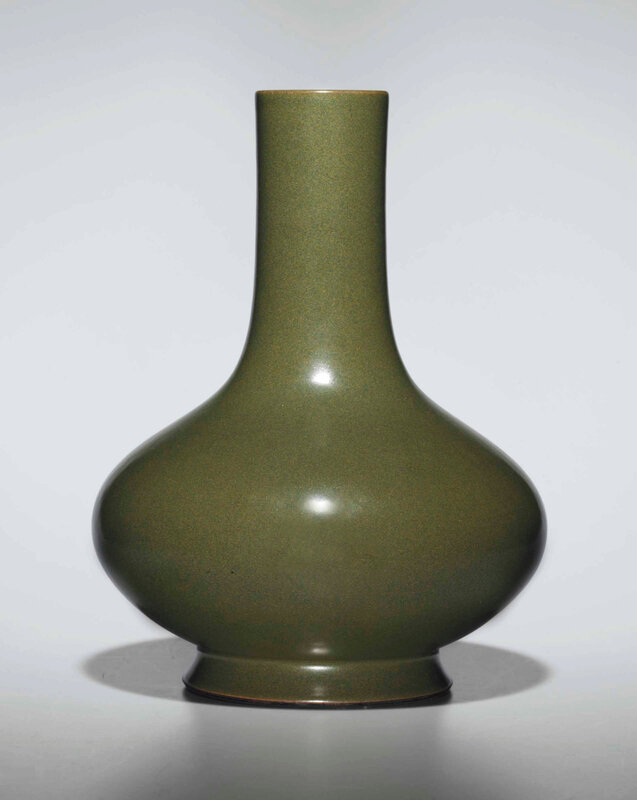Bonhams. Fine Chinese Art, London, 16 May 2019
A large teadust-glazed pear-shaped vase, Impressed Qianlong seal mark and of the period (1736-1795)
Lot 31. A large teadust-glazed pear-shaped vase, Impressed Qianlong seal mark and of the period (1736-1795);33cm (13in) high. Estimate £ 40,000 - 60,000 (€ 46,000 - 69,000). © Bonhams 2001-2019
The compressed pear-shaped body rising from a spreading foot and tapering to a tall cylindrical neck, all covered with an evenly-mottled dark yellow-green glaze stopping at the foot, the base with the impressed seal mark.
Provenance: Sotheby's London, 12 and 13 July 2006, lot 161
The Inder Rieden Collection
Bonhams London, 10 November 2011, lot 66.
Note: The present vase is notable for its lustrous and rich tea-dust glaze which was inspired by the patina characterising archaic bronzes. The distinctive glaze type, first occurring during the Tang dynasty (618-907), was revived on Imperial wares of the 18th century during the Yongzheng and Qianlong reign. The finer tea-dust-glazed products of this period were linked to Tang Ying (1682-1756), the illustrious supervisor at Jingdezhen. Entering the Imperial Household Department in Beijing at the age of 16, he had close control of the imperial kilns until 1756. His 'Commemorative Stele on Ceramic Production' Taocheng jishi bei ji (陶成紀事碑記), compiled in 1735, treated 57 types of porcelain wares, including the 'tea-dust' wares, which are mentioned among the 40 types of monochrome glazes as existing in three variants: eel-skin yellow, snake-skin green, and speckled yellow. This type of glaze was achieved through the precipitation of yellow crystals that stood out against the dark green background, producing the resulting chayemo (茶葉末) or 'tea-leaf dust' effect, which gave a rather rich and velvety appearance to the glaze.
Compare with a closely related vase, Qianlong seal mark and of the period, from the Meiyintang Collection, illustrated by R.Krahl, Chinese Ceramics from the Meiyintang Collection, London, 1994-2010, vol.2, no.936; another example, Qianlong seal mark and of the period, in the Victoria and Albert Museum, London, is illustrated by R.Kerr, Chinese Ceramics: Porcelain of the Qing Dynasty 1644-1911, London, 1986, pl.25.
Porcelain vase with 'tea dust' green glaze, Qianlong period (1736-1795), Jingdezhen, Height: 33.3 cm. Museum number: 735-1883. © Victoria and Albert Museum, London.
Two teadust-glazed vases, Qianlong seal mark and of the period, of similar shape to the present one, were sold at Sotheby's New York, 20 March 2018, lot 437 and Sotheby's Hong Kong, 3 October 2017, lot 3665; a further example was sold at Christie's New York, 17th March 2017, lot 1245.
From the Collection of Gerson and Judith Leiber. A fine teadust-glazed bottle vase, Qianlong seal mark and period (1736-1795). Height 13 in., 33 cm. Sold for 75,000 USD at Sotheby's New York, 20 March 2018, lot 437. Photo Sotheby's.

A fine teadust-glazed bottle vase, incised seal mark and period of Qianlong (1736-1795), 33.8 cm, 13 3/8 in. Sold for 1,687,500 HKD at Sotheby's Hong Kong, 3 October 2017, lot 3665. Photo: Sotheby's.
Cf. my post: A fine teadust-glazed bottle vase, incised seal mark and period of Qianlong
A teadust-glazed vase, Qianlong impressed six-character seal mark and of the period (1736-1795); 13 in. (33 cm.) high. Sold for 247,500 USD at Christie's New York, 17th March 2017, lot 1245. Image courtesy Christi'es.

/https%3A%2F%2Fprofilepics.canalblog.com%2Fprofilepics%2F1%2F0%2F100183.jpg)
/https%3A%2F%2Fstorage.canalblog.com%2F03%2F02%2F119589%2F96711876_o.jpg)
/https%3A%2F%2Fstorage.canalblog.com%2F11%2F31%2F119589%2F94773502_o.jpg)
/https%3A%2F%2Fstorage.canalblog.com%2F20%2F83%2F119589%2F94772815_o.jpg)
/https%3A%2F%2Fstorage.canalblog.com%2F26%2F72%2F119589%2F75604929_o.jpg)
/https%3A%2F%2Fstorage.canalblog.com%2F59%2F60%2F119589%2F26458628_o.jpg)









/image%2F1371349%2F20240416%2Fob_65a1d8_telechargement-31.jpg)
/http%3A%2F%2Fstorage.canalblog.com%2F54%2F95%2F119589%2F129597348_o.jpg)
/http%3A%2F%2Fstorage.canalblog.com%2F15%2F88%2F119589%2F128669670_o.jpg)
/http%3A%2F%2Fstorage.canalblog.com%2F39%2F88%2F119589%2F128455132_o.jpg)